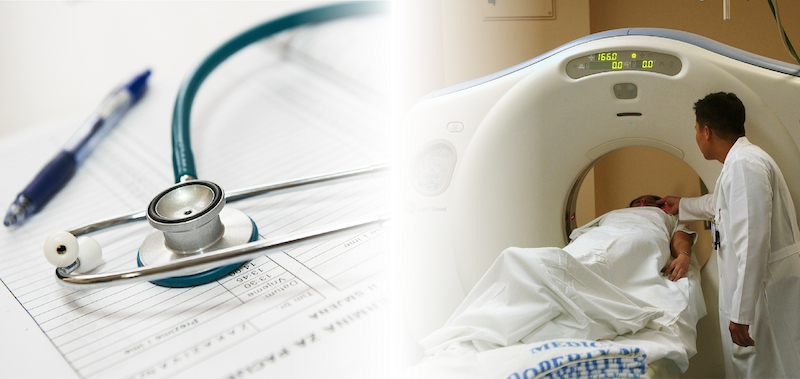Over recent years, we have been involved and successfully completed numerous research and consultancy projects in medical and health sciences, clinical studies, and associated areas. These projects were related to:
- Development of new diagnostic biomarkers and techniques;
- Analysis of clinical trials and their outcomes;
- Development and evaluation of new treatments and interventions;
- Evaluation of drug effects;
- Assessment of psychological impacts on diseases and health, etc.;
Some of the selected projects involving our members are briefly discussed below.
DRAGON Score Biomarker for Acute Ischemic Stroke
DRAGON score calculated from 0 to 10 was introduced and developed as a diagnostic biomarker for prediction of functional outcomes in acute ischemic stroke patients. The current study was conducted in collaboration with The Queen Elizabeth Hospital and University of Adelaide. The study involved more than 1000 ischemic stroke patients from around 16 Australian stroke centres. The DRAGON score was calculated on the basis of 7 independent variables characteristic for this condition. The dependent variable was the modified Rankin Scale (mRS) score (typically used as a measure of degree of disability) at 3 months after the stroke onset.
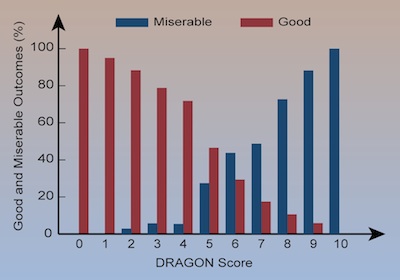 Multinomial mixed effects logistic regressions with clustering determined the probabilities of good, intermediate and miserable outcomes defined on the basis of the 3-month mRS score and adjusted for different hospitals, their locations and other independent variables. Relative importance of the considered independent variables was determined using the model averaging procedure.
Multinomial mixed effects logistic regressions with clustering determined the probabilities of good, intermediate and miserable outcomes defined on the basis of the 3-month mRS score and adjusted for different hospitals, their locations and other independent variables. Relative importance of the considered independent variables was determined using the model averaging procedure.
As a result, a significantly improved DRAGON score constructed as a combination of the 7 categorised variables was introduced and justified. The probabilities of the good and miserable outcomes were determined as functions of the improved DRAGON score.
The improved DRAGON score threshold for the miserable outcome (with ~ 0.73 sensitivity) was determined using the ROC regression analysis.
Re-epithelialisation in Pediatric Burn Injury
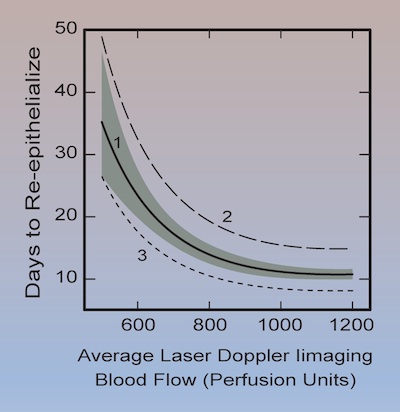 This project was conducted in collaboration with the Queensland Children's Medical Research Institute and The University of Queensland.
This project was conducted in collaboration with the Queensland Children's Medical Research Institute and The University of Queensland.
The goal was to determine the dependences between the number of days from the injury to ≥ 95% re-epithelialisation (as the dependent variable) and the independent variables including burn depth measured using laser Doppler imaging, total body surface area injured by a burn, self-reported level of pain, ethnicity, mechanism of injury, days post-injury to present to the burn centre, age, gender, site of injury, first aid, etc.
A total of 106 burn wounds were analysed from 77 participants aged 4-12 years.
Because of the presence of multiple burns on some patients, the two-level mixed effects multiple linear regression with random intercepts (Level 1: individual burn; Level 2: individual patient) was used to evaluate the impacts of the independent variables adjusted for each other.
Typical outcomes are illustrated by figure on the left for patients from ethnicities with lighter skin and scald burns (curve 1), for patients with lighter skin and flame burns (curve 2), and for patients with darker skin and scald burns (curve 3).
Brown, N.J., et al. (2014). Predictors of re-epitheliazation in pediatric burn. Burns, 40, pp. 751-758.
Anticholinergic Cognitive Burden in Elderly Patients
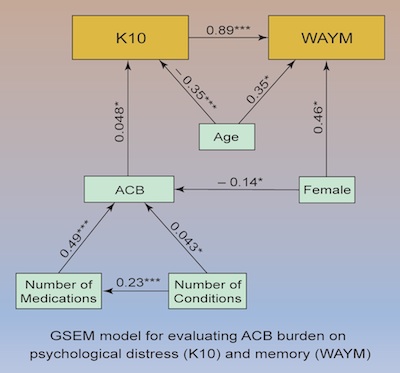 This project was conducted to evaluate the impact of medications with anticholinergic properties on the level of psychological distress and memory of geriatric patients.
This project was conducted to evaluate the impact of medications with anticholinergic properties on the level of psychological distress and memory of geriatric patients.
The overall anticholinergic cognitive burden (ACB) was calculated on the basis of medications consumed by each participant, while the level of psychological distress and memory were evaluated by means of the Kessler Psychological Distress Scale (K10) and the Worried About Your Memory (WAYM) questionnaire.
Factor analysis was used to create the K10 and WAYM constructs from the questionnaire data. These constructs were used as the dependent latent variables characterised by their factor scores in the GSEM model (figure on the right).
The model predicted a significant increase in memory worries with increasing psychological distress. At the same time, there was no significant direct effect of ACB on memory (the WAYM variable), but there was a significant indirect effect of ACB on WAYM through the K10 variable (figure on the right).
Integrated Biomarkers for Parkinson Disease
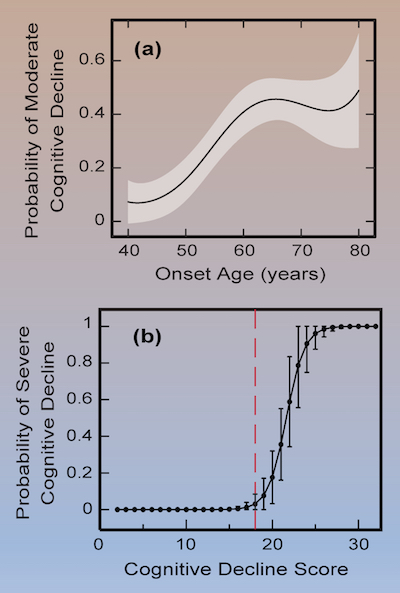 This project is being conducted on the basis of the data available from Michael J Fox Foundation (MJFF) and Parkinson's Progression Markers Initiative (PPMI).
This project is being conducted on the basis of the data available from Michael J Fox Foundation (MJFF) and Parkinson's Progression Markers Initiative (PPMI).
The study aims at the development of new integrated biomarkers for diagnostics and progression of Parkinson's disease (PD). These biomarkers are constructed as weighted combinations of biochemical measures (such as alpha-SYN, amyloid beta peptide, t-tau, p-tau, etc.) and clinical measures calculated using the clinical scales such as Unified Parkinson's Disease Rating Scale (UPDRS), Montreal Cognitive Assessment (MoCA), etc.
Factor analyses were used for the evaluation of the clinical measures. Model averaging approach was used for the evaluation of relative importance of multiple predictor variables and their potential contributions to the integrated biomarkers. ROC regression analysis evaluated specificity and sensitivity of the biomarkers.
Simple clinical scores were developed as new clinical biomarkers for prediction of risks for PD patients to develop severe and mild/moderate cognitive declines (Fig. (b)). Significantly non-linear dependence of cognitive decline of PD patients on onset age was also discovered (Fig. (a)).
We expect that this project will lead to a breakthrough in the development of reliable markers for diagnostics and progression of PD.
Gramotnev, G., et al. (2019). Parkinson’s disease prognostic scores for progression of cognitive decline. Scientific Reports, 9, 17845.

